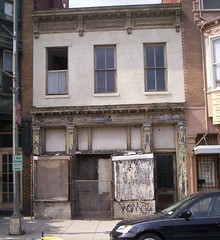Urban pioneering
One of the interesting things about the H Street "alley" tour that I do in conjunction with the CulturalTourismDC WalkingTown DC affair is that it is kind of an "old home week"/opportunity for reflection and assessment.
It's a tour not just of alleys, but places along the route, ranging from a discussion of the Uline Arena to commercial district revitalization along H Street. Of course, the highlight for attendees is a tour of an alley house immediately behind H Street.
As the tour group is a mix of people, you get a range of questions, and some people think that H Street looks like crap (and it does sort of) not recognizing what it was during the heyday, or the many decades of effort that have gotten it to the point where it is today.
It was an interesting contrast yesterday between two women, both with gray hair, both in their 60s. One lives in Laurel, the other on Lincoln Park. The woman from Lincoln Park (eastern Capitol Hill), has lived in either Chicago or DC for the last 40 years and she biked to the starting point of the tour (and expressed some trepidation leaving the bike locked up at the New York Avenue Metro Station). She talked with me afterwards about finally seeing some of the payoff of years and years of living in urban settings, and having to deal with all the grief and difficulty of what urban pioneering and rebuilding and revitalizing urban neighborhoods really means.
The woman from Laurel constantly questioned things, including why people would want to live in a neighborhood like H Street, given its perceived lack of amenities.
The thing is that they are both right. H Street still looks like hell, partly that's due to street reconstruction as well as continued disinvestment not to mention the real estate downturn, unless you know what you're looking for.

This building on NE H Street has been vacant for the entire 22 years I have lived in Washington, DC. (I first moved to the city in September 1987, and I lived about a block from this building.) It's owned by what we might call a slumlord, a person who lives comfortably in the upper NW DC neighborhood of American University Park. Note that it has been painted recently... But this kind of disinvestment is the story of H Street too.
On the other hand, walking through the H Street Festival on Saturday, or while giving the tour ought to give one an appreciation for how much work has been expended by so many people.
For example, running into Drew Ronneberg, who has chaired the ANC6A Economic Development and Zoning Committee for a number of years, and who is one of the neighborhood's leading proponents of quality design and thoughtful infill development; or Anwar Saleem--Anwar and I have had our differences, now he's the director of the H Street Main Street program (like Anwar, I am one of the co-founders), and people have no idea of how hard it is to pull off an event like the H Street Festival, which after fits and starts looked great Saturday (even though most people don't know final clearances and permits were only received Friday).
Now in response to questions on the tour, I opined that H Street's revitalization has been accelerated by at least 5 years through the various efforts of Joe Englert (see "On H Street, a New Spot for Swingers" from the Washington Post, "So What Exactly Does Joe Englert Do During an Average Day?" from the Washington City Paper, and "Signs of Recovery in a 'Riot Corridor'" from the New York Times) despite the wonderful actions of the H Street Playhouse and the creation of the Atlas Performing Arts Center.
Still, H Street has experienced roughly 60 years of disinvestment--since the end of World War II as the neighborhood began experiencing significant outmigration of population, for 20 years before the riots in 1968, and 40 years since.
It takes more than a few years to right decades of disinvestment, whether or not people read about the new H Street in newspapers or go to a funky tavern, theater performance or concert.
It takes a lot of people too. People come and go. We get burned out. People die and soon enough, their contributions are forgotten. I think of all the people who worked on issues before me, and of how "later generations" are getting ready to move on as well.
All I can say is there is too much to do to be able to expect positive things to happen without your contribution.
Labels: civic engagement, protest and advocacy, urban design/placemaking, urban revitalization



0 Comments:
Post a Comment
<< Home